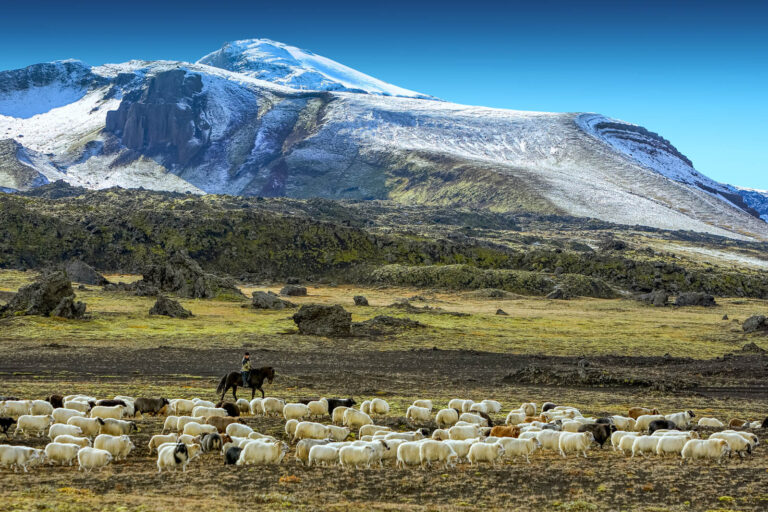
I defy you not to become a twitcher on a voyage around Spitsbergen! So prevalent and conspicuous are the birds that live in these remote and extreme locations that you simply fall under an avian spell. From the procession of fulmars that draft your ship as you cruise along the Svalbard coastline to the raucous bird cliffs where thousands of kittiwakes and guillemots nest, birds are a constant companion.
Small ship voyages – those under 200 passengers – are the perfect way to immerse yourself in this avian idyll. Surrounded by ice-speckled waterways, dramatic glaciers, untouched tundra and rugged snow-capped mountains, you feel an intimate connection to your surroundings. This is the natural world on steroids! Though, far from human habitation, these are nevertheless densely populated areas… mostly of the feathered variety. Whether watching from deck, out exploring on Zodiac cruises or on shore landings, the chances to becomes obsessed with birds are plentiful.
Here’s a simple guide to the birds of Svalbard you’ll likely encounter.

Atlantic puffin
The oversized, bright orange beak of this bird makes it unmistakable, at least up close, and one of the bigger draw cards in the Arctic. Puffins became the bird “de jour” on my Svalbard voyage, with everyone keen to spot the ‘penguin on the north’. Also known as ‘clowns of the sea’ for their comical demeanour on land, there’s something very engaging about this distinctive bird. Puffin numbers in the high Arctic are relatively small, making a sighting even more special.

Northern fulmar
Graceful in flight and quite playful, you’ll enjoy the company of this member of the petrel family as you cruise along the Arctic coast. Watching fulmar draft your ship is almost mesmeric and certainly great for photographers looking to capture birds flying. There’s something herculean about this bird, which bears a passing resemblance to the workhorse military transport aircraft, the C-130 Hercules. Heavyset, it has protruding nasal tubes on its bill and its grey and white colouring blends with the soft tonal palette of Svalbard. It is a member of the petrel family and with its stiff wings is similar to a small albatross in flight.

Little auk
Despite being the most abundant bird in Svalbard, these diminutive members of the auk family are often easier to hear than see up close. Black and white like all auk, they are small in size with a very compact bill. Nesting in their thousands on packed cliffs, there are millions of breeding pairs across the archipelago. Streaming from their nesting ledges, like darting arrows and reaching speeds of up to 70kph – stunning to watch, hard to photograph.

Guillemot
Where to start with guillemots? You will see many on a voyage – nesting on teeming bird cliffs, bobbing gently on the ocean, resting on sea ice and diving for small fish. The challenge with this black, and by degrees, white bird is identification. Black, common and Brunnich’s guillemots can all be seen. Ironically, the common guillemot may be the most aloof. Black guillemots are unsurprisingly predominantly black, with large white patches on the wings and jazzy little red legs. Brunnich’s guillemots are black with a white breast and a characteristic white strip along the bill. Brunnich’s are also the most northerly of the breeds and the colonies are staggering in number, with several million pairs around Svalbard. This is the guillemot you will likely become most familiar with.

Common Eider duck
This is the most numerous of the duck species, with around 17 thousand pairs nesting around the Svalbard archipelago. Supposedly boasting the warmest feathers of all ducks, the male of this feisty bird cuts a striking figure in black and white with flashes of yellow. The wedge-shaped bill gives both male and female an elegant distinction over other duck species.

Kittiwake
White with grey, black tipped wings and lemon-yellow bills, this prolific bird is part of the gull family. Masters of upcycling, kittiwakes seem as comfortable nesting near human settlements as the steep cliffs that are the more natural environment. A chatty bird, it is named after the sound of its call. With fish a large part of the kittiwake’s diet, the inevitable churn as ships navigate sea ice, sets up an all you can eat buffet for this popular seabird, providing an electrifying spectacle for voyagers.

Snow bunting
These petite beauties dash around with purpose and agility. Also known as the ‘Arctic sparrow, they are most easily spotted around settlements such as Longyearbyen. Pure white during winter, seeds are the main food source, though they hunt for insects over the tundra in summer.

Arctic tern
Last, but never least, the Arctic tern is a Discover the World favourite. It is, after all, the bird within our logo – chosen for its extraordinarily long annual migration from the Arctic to Antarctica. Not a gull, it is the only tern to be found in the Arctic. Arriving in Spitsbergen in mid-May, these remarkable birds stay for around three months before resuming the journey back to the Southern Ocean in time for the Antarctic summer. That’s somewhere in the range of 50,000 frequent flyer miles banked each year!
Plan your own Arctic cruise
With a wide choice of small-ship expedition vessels to choose from, speak to our team for advice of which Svalbard voyage is best for you to get your bird fix. Get in touch with our Polar Travel Specialists to discuss your options on 01737 214 250 or send an enquiry.






 Instagram
Instagram
 Facebook
Facebook
 YouTube
YouTube